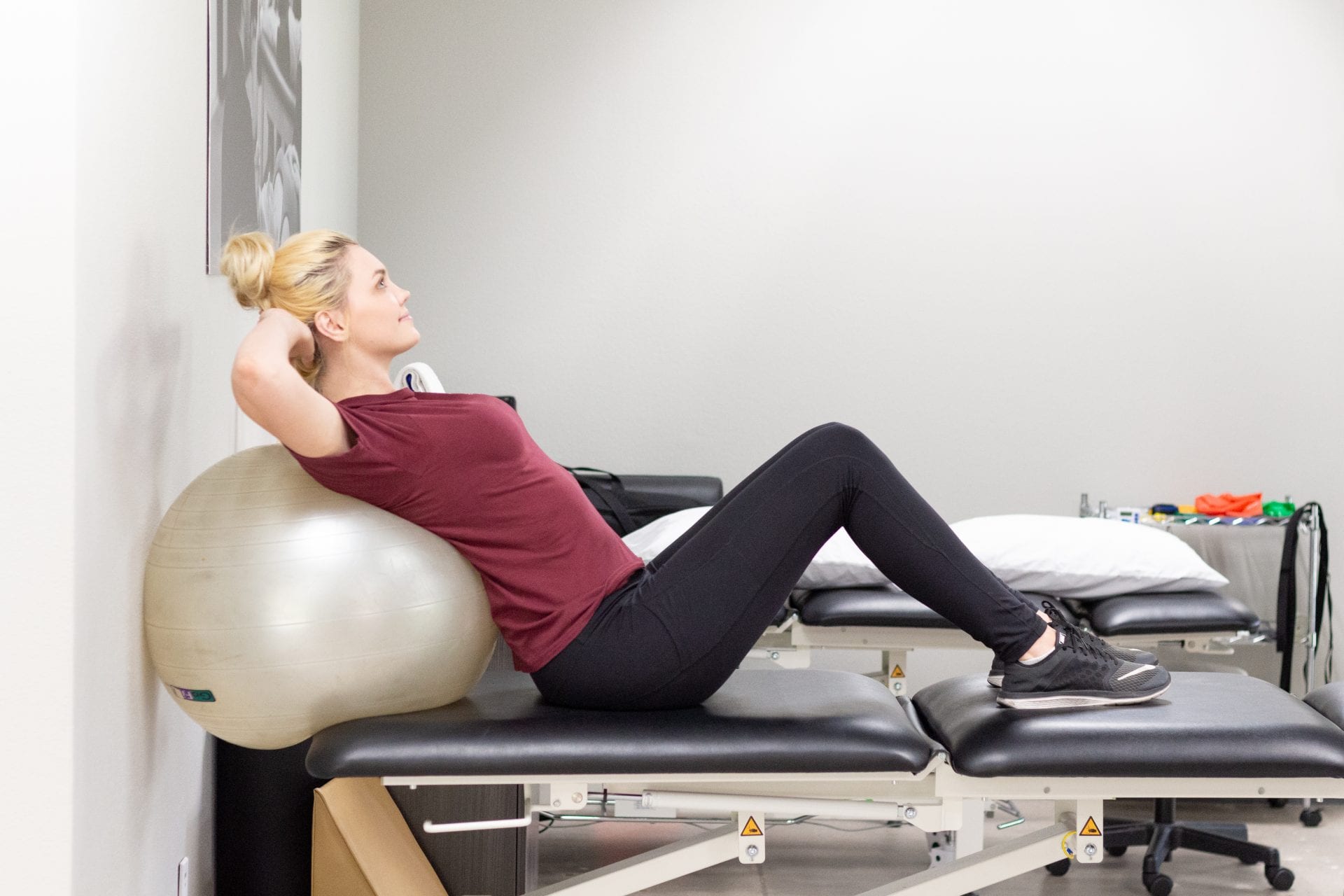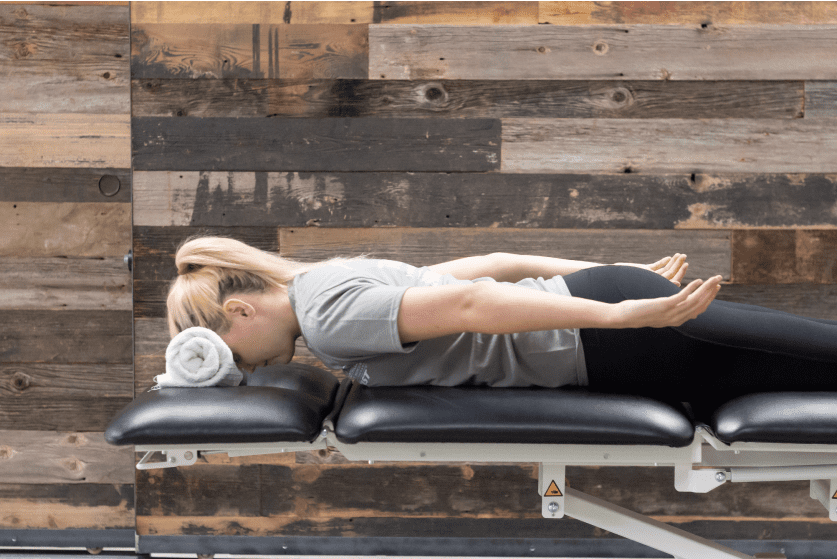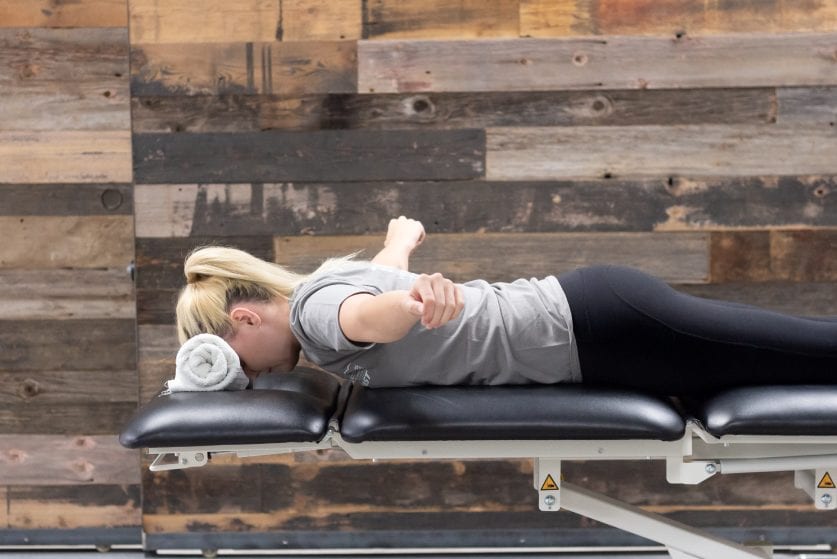by Lauren Keel PTA, AT, CES | South Chandler Location
Upper back pain, also known as thoracic pain, is a problem many people experience. Individuals work at their computers for hours and don’t realize their posture is worsening. Eventually, this leads to poor posture characterized by rounded shoulders and a forward head. They may experience upper back strain, neck pain, lower back pain, and even headaches associated with muscle tightness and weakness.
An important factor to consider is the workplace. In my experience, many people who come to me for upper back pain therapy sit at a desk or on a plane traveling for long periods. The advice I usually give to a patient is to look at their workspace and habits. Check if your work has someone who can come out and make ergonomic adjustments for you. If not, I usually instruct them to take a photo of the workspace and give them pointers. A standing desk is becoming more popular, and people have had good results. If your workplace doesn’t offer a standing desk, try limiting your time at the computer. If you lose track of time, set a timer for 15 minutes. Get up, stretch, and walk around when the timer goes off.
If you try to alleviate your pains without therapy, here are some exercises I’ve used that had good results. They include self-joint mobilization, stretches, and strengthening exercises. When you sit for long periods, the thoracic spine is flexed, and you start losing spinal mobility moving into extension — these exercises work to combat that.
Stretching to Eliviate Upper Back Pain
Different exercises that stretch your upper back include physioball mobilizations (PB mobs), doorway stretch, and an upper stretch.
Physioball Mobilizations (PB Mobs) – One exercise I like for spinal mobility is called physioball mobilizations or PB mobs. You do this by sitting against a physioball — an exercise ball — with your knees bent and your hands cradling your head for support. Next, you extend your back over the ball until you feel a stretch in your upper back. There shouldn’t be any neck motion in this exercise. Complete two sets of five repetitions.

Doorway Pectoral Stretch – A doorway stretch (pectoral stretch) begins with you facing forward and placing your arms against the doorframe in a 90-degree position. Next, you slowly lean forward until you feel a slight stretch.
Upper Trap Stretch – An upper trap can be performed seated at your desk. Sit up tall and look forward. Next, slowly try to bring your ear to your shoulder. Be careful that your shoulder doesn’t lift, and your head isn’t rotating. You can use your hand to give slight overpressure to get more of a stretch. Do this two times and hold for 20–30 seconds at a time.
Strengthening for Upper Back Pain Prevention
Some strengthening exercises to start with are scapular squeezes, prone I, and prone T’s.
Scapular Squeeze – A scapular squeeze is performed sitting with your hands relaxed on your thighs. You then think about bringing your shoulders down and back. Do this with a five-second squeeze and try to complete 10.
Prone I and T’s – Prone I and T’s are performed face down on a table (bed, floor, or physioball can also be used). Roll up a towel and put it under your forehead, arms down at your side with palms facing the ceiling, and start to squeeze your shoulder blades together and lift your arms off the table. Do a five-second hold and then lower them back down ten times. Prone T’s are performed in the same position, but arms are now moved out to the side with the palms facing the floor. Now squeeze your shoulder blades together and lift your arms. Do this with a five-second hold ten times.
Prone I

Prone T

A program like this should be done consistently and progress as it gets easier. Physical therapy can help determine when to start progressing if you’re unsure. I recommend performing a program with these exercises daily. The strengthening portion can be done every other day, and you can start incorporating other exercises, like rows, over time. You can add weight to fairly easy exercises as long as you maintain proper form. The stretches can be done multiple times during the day.
A Typical Physical Therapy Visit
A typical visit includes a manual therapy component if you go the physical therapy route. This involves manual stretching, soft tissue massage, and joint mobilizations. We can also add Kinesio taping to help decrease pain and increase awareness of the muscles involved. I’ve used this on upper traps to get them to relax due to compensation because of pain or limitation contributing to poor posture. We also utilize modalities such as moist hot packs to get muscles to relax and ultrasound, ice packs, and electrical stimulation to decrease pain.
Upper back pain is a common complaint by those working at a desk, traveling, or performing tasks that require sitting for long periods. Strengthening weak muscles and stretching out tight muscles can help increase your body’s tolerance for those jobs. Another way to deal with upper back pain is by looking at ergonomic options or possibly a standing desk. This will allow you to control how much you want to sit and stand during the day. If trying these back pain therapy exercises alone for a period of time doesn’t decrease your pain, I would look into getting a physical therapy consultation to ensure you can get back to being pain-free and back to what you want to do.
Arizona is a direct access state, which means that you can go see a physical therapist without a physician’s referral (insurance may vary). We offer free Injury Assessments and will be able to help you with upper back pain. Schedule your appointment today.



